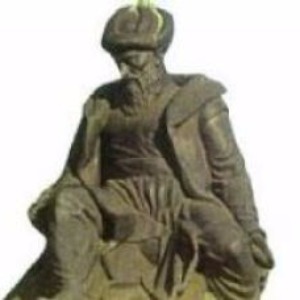Sufi and professor, mathematician (Born 1258 or 1261, Kayseri - Death ?). His
full name is Şerefüddin Davud b. Mahmud b. Muhammed Davud-i Kayseri. He started primary education in Kayseri. Methodology and
logics scholar, Siracuddin Mahmut el-Urmevî, was one of his professors here. He
went to Egypt
to increase his knowledge and experience in religious sciences after being
instructed at these. On his return from Egypt, he studied physical sciences
at the Madrasah of Nizamuddin Yağıbasan in Tokat-Niksar (Nizâmiyye Medresesi) with
İbn Sartak el-Vararkinî who is a representative of Merağa
mathetmatics-astronomy school. Later he met Abdurrezzâk el-Kâşanî (D. 1339) at
Save town of Iran.
He was assigned as head of professors (a kind of chancellor) to the Madrasah of
Iznik which is established in 1336-37 as the first Ottoman Madrasah. He stayed
there until his death.
Davud-i Kayseri
had a decent education in rational (positive sciences such as
mathematics, literature and logics) and religious sciences (Islamic sciences such as interpretation, kalam, hadith and fiqh).
Although he possessed a deep knowledge in fiqh (Islamic law) and hadith (words
of the Prophet) fields, he was rather distinguished in kalam (explanation of
faith issues using rational proofs) and sufism. On the other hand, it can be
said that he also acquired the knowledge accumulation of Merağa School
in the field of physical sciences through his teacher Ibn Sartak el-Vararkinî
who actively worked in the observatory and madrasah under the second period of
Nasiruddin el-Tusî’s second son Asiluddin Hasan’s (D. 1315) rule of Merağa
mathematics-astronomy school. Besides, he met through Ibn Sartak prominent
figures of Greek mathematics and philosophy such as Aristotle, Apollonius and Akaton;
and of classical Islamic mathematics such as el-Kindî, el-Harizmî, Sabit b.
Kurra, İbn Heysem, İbn Salâh and
el-Kûhî. On the other hand, he wrote down his teacher Ibn Sartak’s “Risâle
el-usûl el-asîliyye fi el-hendese” between 1314-16 in
Niksar and his work related to geometric mathematics (plane geometry, solid
geometry, conic sections, plane and spherical trigonometry, geometric numbers
theory and geometric algebra) “Kitab el-ikmâl el-asîlî fi el-hendese”
and also studied them.
Ibn Sartak gives Sufi-mystical interpretations of some geometric
shapes such as ellipse, parabola and hyperbola in his work titled “Kitab
el-ikmâl el-asîlî fi el-hendese” referring to a person named el-Tamati.
This attitude not only proves that Ibn Sartak belongs to Sufi path but also
that this mathematical education had an important place for Davud el-Kayseri’s
initiation into Sufism.
Davûd-i Kayseri transferred the
classical scientific heritage to Ottomans, especially the knowledge
accumulation of Merağa mathematics-astronomy school. His works put down on
paper by Ibn Sartak were beside him during his education in İznik. They have
seals of Fatih Sultan Mehmet and Sultan Beyazıt II which proves that these
works belonged to the Palace. It is also known that these works were taught in
Enderun school (School of
Palace).
Another characteristic of Davûd-i Kayseri’s
mentality is his adoption of the Sufi understanding of “existence of unity”
developed by İbn el-Fârız, İbn el-Arabî and Abdurrezzâk el-Kâşanî. Besides, he
is the first thinker to interpret this Sufi understanding
philosophically. Although he adopted the existence of unity he never became a
member of Sufi order and a spiritual leader to conduct guidance activities in
Sufi path. Nevertheless he influenced Ottoman scholars deeply with his works in
the field of Sufism such as Şeyh Bedreddin, Molla Fenarî, Kutbuddin İznikî,
Sofyalı Balî Efendi, Abdullah Bosnevî and İsmail Hakkı Bursevî. Besides he also
had an influence on scholars who lived in Altın Ordu, İran, Arabic World and
Indian Subcontinent. Especially the Iranian philosopher Molla Sadrâ el-Şirâzî (D.1640),
the famous Sufi Abdülgani el-Nablusî (D.1791) and the national hero of Algeria Emir Abdülkadir (D.1883) can be mentioned among
them. His interpretation of İbn el-Arabî’s “Fusûs el-Hikem” is still
studied in Iran and India.
Davûd el-Kayseri is an important name in Islamic-Ottoman thought. He
reconstructed in general the Sufi exploration (Discourse of Wisdom) and
inspiration, in particular the unity of existence in proving terms, in other
words in the language of the madrasah. Accordingly it was evaluated as a
success of him that he provided a certain harmony between the Seljuk-Ottoman
madrasah tradition and the Sufi tradition in terms of language. This unity of
language he established between the discourse of wisdom and discourse of proof
carry the influence of logical and mathematical education on him. It was
claimed that Davûd el-Kayseri enlivened primarily the madrasahs and also to
Ottoman scientific and cultural understanding in a Sufi-mathematical way. This
was united with the understanding of kalam-mathematics which dominated the
scientific understanding reconstructed by Ali Kuşçu and his friends with its
center being Istanbul. Thus the scientific
framework on which the Ottoman thinking would proceed for six hundred years
were based on these fundaments. It is assumed that Davûd-i Kayseri’s
grave is in İznik, in Çamdibi place across Çandarlı Halil Paşa Mosque.
MAIN
WORKS:
ŞerhuFüsûsı’l-Hikem, Risâletüfî’ilmi’t-Tasavvufi,
ŞerhuTe’vilâti’l-Besmele bi’s-Sûrâti’n-Nev’iyyeti’l-İnsâniyyeti, Keşfu’l-Hıcabi’anKelâmi
Rabbi’l-Erbâbi, Risaletü fi Marifeti’l-Mahabbeti’l-Hakikiyyeti, Esasü’l-Vahdaniyyeti
v eMenbâ'i’l-Ferdaniyyeti, Nihayetü’l-Beyan fi Dirâyeti’z-Zemân,
er-Resail (Edited by Mehmet Bayrakdar (The introduction part is Turkish,
Istanbul 1997), Mukaddemat (Matla-u hususi’l-kelim fi Meani
Fususi’l-Hikem, (Turan Koç - Hasan Şahin - Seyfullah Sevim, Kayseri 1997),
Mukaddemat-Fusûsu’l-Hikem’e Giriş (Translated by Turan Koç - Mehmet Çetinkaya,
2011), Aşk Şarabı ve Hayat (Translated by Turan Koç - Mehmet Çetinkaya,
(2011).
REFERENCE: Kemal Beydilli / Türk Bilim Tarihi ve
Matbaacılık Tarihinde Mühendishane Matbaası ve Kütüphanesi: 1776-1826 (s. 282,
378, 389, 401, 413 1995), Mehmed Bayraktar / Kayserili Davud (s. 31-33, Ankara
1988) – TDV İslam Ansiklopedisi (c. 9, s. 32-35, 1994), Uluslararası Davud
el-Kayserî Sempozyumu (Kayseri 1998), İhsan Fazlıoğlu / Uluslararası Dâvûd
el-Kayserî Sempozyumu Tebliğleri (Kayseri 1998, s.25-42) - Yaşamları ve
Yapıtlarıyla Osmanlılar Ansiklopedisi (c. I, s. 370-371, 1999), İhsan Işık / Ünlü Bilim Adamları (Türkiye Ünlüleri
Ansiklopedisi, C. 2, 2013) - - Encyclopedia of Turkey’s Famous People (2013) - Resimli
ve Metin Örnekli Türkiye Edebiyatçılar ve Kültür Adamları Ansiklopedisi (C. 12,
2017).
